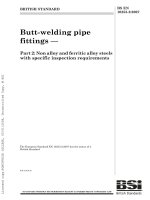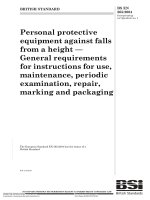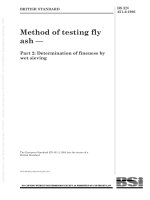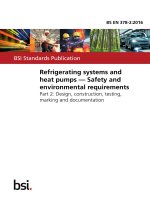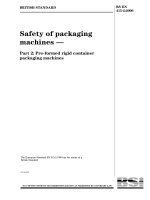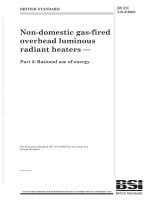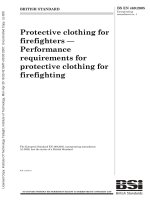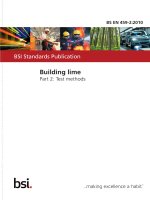Bsi bs en 61804 2 2007
Bạn đang xem bản rút gọn của tài liệu. Xem và tải ngay bản đầy đủ của tài liệu tại đây (1.39 MB, 66 trang )
Licensed copy: University of Auckland Library, University of Auckland Library, Version correct as of 20/05/2012 08:54, (c) The British Standards Institution 2012
BS EN 61804-2:2007
BSI Standards Publication
Function blocks (FB) for
process control —
Part 2: Specification of FB concept and
Electronic Device Description
Language (EDDL)
NO COPYING WITHOUT BSI PERMISSION EXCEPT AS PERMITTED BY COPYRIGHT LAW
raising standards worldwide™
BRITISH STANDARD
Licensed copy: University of Auckland Library, University of Auckland Library, Version correct as of 20/05/2012 08:54, (c) The British Standards Institution 2012
BS EN 61804-2:2007
National foreword
This British Standard is the UK implementation of EN 61804-2:2007. It is
identical to IEC 61804-2:2006. Together with BS EN 61804-3:2007, it
supersedes BS EN 61804-2:2004 which is withdrawn.
The UK participation in its preparation was entrusted to Technical Committee
AMT/7, Industrial communications: process measurement and control,
including fieldbus.
A list of organizations represented on this committee can be obtained on
request to its secretary.
This publication does not purport to include all the necessary provisions of a
contract. Users are responsible for its correct application.
© BSI 2010
ISBN 978 0 580 70026 2
ICS 25.040.40; 35.240.50
Compliance with a British Standard cannot confer immunity from
legal obligations.
This British Standard was published under the authority of the
Standards Policy and Strategy Committee on 28 February 2010
Amendments issued since publication
Amd. No.
Date
Text affected
Licensed copy: University of Auckland Library, University of Auckland Library, Version correct as of 20/05/2012 08:54, (c) The British Standards Institution 2012
EUROPEAN STANDARD
EN 61804-2
NORME EUROPÉENNE
EUROPÄISCHE NORM
June 2007
ICS 25.040.40; 35.240.50
Partially supersedes EN 61804-2:2004
English version
Function blocks (FB) for process control Part 2: Specification of FB concept
(IEC 61804-2:2006)
Blocs fonction
pour les processus industriels Partie 2: Spécification du concept
de bloc fonction
(CEI 61804-2:2006)
Funktionsbausteine
für die Prozessautomation Teil 2: Festlegung
des Funktionsbausteinkonzepts
(IEC 61804-2:2006)
This European Standard was approved by CENELEC on 2007-05-01. CENELEC members are bound to comply
with the CEN/CENELEC Internal Regulations which stipulate the conditions for giving this European Standard
the status of a national standard without any alteration.
Up-to-date lists and bibliographical references concerning such national standards may be obtained on
application to the Central Secretariat or to any CENELEC member.
This European Standard exists in three official versions (English, French, German). A version in any other
language made by translation under the responsibility of a CENELEC member into its own language and notified
to the Central Secretariat has the same status as the official versions.
CENELEC members are the national electrotechnical committees of Austria, Belgium, Bulgaria, Cyprus, the
Czech Republic, Denmark, Estonia, Finland, France, Germany, Greece, Hungary, Iceland, Ireland, Italy, Latvia,
Lithuania, Luxembourg, Malta, the Netherlands, Norway, Poland, Portugal, Romania, Slovakia, Slovenia, Spain,
Sweden, Switzerland and the United Kingdom.
CENELEC
European Committee for Electrotechnical Standardization
Comité Européen de Normalisation Electrotechnique
Europäisches Komitee für Elektrotechnische Normung
Central Secretariat: rue de Stassart 35, B - 1050 Brussels
© 2007 CENELEC -
All rights of exploitation in any form and by any means reserved worldwide for CENELEC members.
Ref. No. EN 61804-2:2007 E
Licensed copy: University of Auckland Library, University of Auckland Library, Version correct as of 20/05/2012 08:54, (c) The British Standards Institution 2012
EN 61804-2:2007
-2-
Foreword
The text of the International Standard IEC 61804-2:2006, prepared by SC 65C, Industrial networks, of
IEC TC 65, Industrial-process measurement and control, was submitted to the formal vote and was
approved by CENELEC as EN 61804-2 on 2007-05-01 without any modification.
This European Standard, together with EN 61804-3:2007, supersedes EN 61804-2:2004.
EN 61804-2:2007 includes the following significant technical changes with respect to EN 61804-2:2004:
– transfer of the EDDL-specific clauses to EN 61804-3;
– the FB-specific subclauses 4.1 and 4.2 as well as Clauses 5, 6, 7 and 8 are unchanged.
The following dates were fixed:
– latest date by which the EN has to be implemented
at national level by publication of an identical
national standard or by endorsement
(dop)
2008-05-01
– latest date by which the national standards conflicting
with the EN have to be withdrawn
(dow)
2010-05-01
The International Electrotechnical Commission (IEC) and CENELEC draw attention to the fact that it is
claimed that compliance with this document may involve the use of patents
U.S. Patent No. 5,333,114
U.S. Patent No. 5,485,400
U.S. Patent No. 5,825,664
U.S. Patent No. 5,909,368
U.S. Patent Pending No. 08/916,178
Australian Patent No. 638507
Canadian Patent No. 2,066,743
European Patent No. 0495001
Validated in:
UK – Patent No. 0495001
France – Patent No. 0495001
Germany – Patent No. 69032954.7
Netherlands – Patent No. 0495001
Japan Patent No. 3137643
The IEC and CENELEC take no position concerning the evidence, validity and scope of this patent right.
The holder of this patent right has assured the IEC that he is willing to negotiate licenses under
reasonable and non-discriminatory terms and conditions with applicants throughout the world. In this
respect, the statement of the holder of this patent right is registered with IEC. Information may be
obtained from:
Fieldbus Foundation,
9390 Research Boulevard, Suite II-250,
Austin, Texas, USA 78759,
Attention: President.
Licensed copy: University of Auckland Library, University of Auckland Library, Version correct as of 20/05/2012 08:54, (c) The British Standards Institution 2012
-3-
EN 61804-2:2007
Attention is drawn to the possibility that some of the elements of this document may be the subject of
patent rights other than those identified above. IEC and CENELEC shall not be held responsible for
identifying any or all such patent rights.
Annex ZA has been added by CENELEC.
__________
Endorsement notice
The text of the International Standard IEC 61804-2:2006 was approved by CENELEC as a European
Standard without any modification.
__________
Licensed copy: University of Auckland Library, University of Auckland Library, Version correct as of 20/05/2012 08:54, (c) The British Standards Institution 2012
EN 61804-2:2007
-4-
Annex ZA
(normative)
Normative references to international publications
with their corresponding European publications
The following referenced documents are indispensable for the application of this document. For dated
references, only the edition cited applies. For undated references, the latest edition of the referenced
document (including any amendments) applies.
NOTE Where an International Publication has been modified by common modifications, indicated by (mod), the relevant EN/HD
applies.
Publication
Year
Title
EN/HD
Year
IEC 60050-351
1998
International Electrotechnical Vocabulary
(IEV) –
Part 351: Automatic control
-
-
IEC 60584-1
-
Thermocouples –
Part 1: Reference tables
EN 60584-1
1995
IEC 61131-3
2003
Programmable controllers –
Part 3: Programming languages
EN 61131-3
2003
IEC 61158
Series Digital data communications for
measurement and control - Fieldbus for use
in industrial control systems
EN 61158
Series
IEC 61499-1
2005
Function blocks –
Part 1: Architecture
EN 61499-1
2005
IEC 61499-2
2005
Function blocks –
Part 2: Software tools requirements
EN 61499-2
2005
IEC/TS 61804-1
2003
-
-
ISO/IEC 7498-1
1994
Function blocks (FB) for process control –
Part 1: Overview of system aspects
Information technology - Open systems
interconnection - Basic reference model –
Part 1: The basic model
EN ISO/IEC 7498-1 1995
ISO/IEC 9899
-
1)
Programming languages - C
-
-
ISO/IEC 10646-1
-
1)
Information technology - Universal MultipleOctet Coded Character Set (UCS) –
Part 1: Architecture and Basic Multilingual
Plane
-
-
1)
2)
1)
Undated reference.
Valid edition at date of issue.
2)
BS EN 61804-2:2007
Licensed copy: University of Auckland Library, University of Auckland Library, Version correct as of 20/05/2012 08:54, (c) The British Standards Institution 2012
–2–
61804-2 IEC:2006(E)
CONTENTS
FOREWORD...........................................................................................................................4
INTRODUCTION.....................................................................................................................6
1
Scope ...............................................................................................................................7
2
Normative references .......................................................................................................7
3
Terms, definitions and abbreviated terms and acronyms...................................................8
4
3.1 Terms and definitions ..............................................................................................8
3.2 Abbreviated terms and acronyms .......................................................................... 14
General Function Block (FB) definition and EDD model .................................................. 14
5
4.1 Device structure (device model) ............................................................................ 14
4.2 Block combinations ............................................................................................... 25
Detailed block definition ................................................................................................. 28
6
5.1 General ................................................................................................................. 28
5.2 Application FBs ..................................................................................................... 28
5.3 Component FBs .................................................................................................... 36
5.4 Technology Block .................................................................................................. 36
5.5 Device (Resource) Block ....................................................................................... 45
5.6 Algorithms common to all blocks ........................................................................... 47
FB Environment.............................................................................................................. 49
7
Mapping to System Management .................................................................................... 49
8
Mapping to Communication ............................................................................................ 49
9
Conformance statement.................................................................................................. 51
Annex A (informative) Parameter description ....................................................................... 52
Annex B (normative) IEC 61804 Conformance Declaration .................................................. 58
Bibliography.......................................................................................................................... 59
Figure 1 – Position of the IEC 61804 series related to other standards and products ..............6
Figure 2 – FB structure is derived out of the process (P&ID view) ......................................... 15
Figure 3 – FB structure may be distributed between devices ................................................. 16
Figure 4 – IEC 61804 FBs can be implemented in different devices ...................................... 17
Figure 5 – General components of devices ........................................................................... 17
Figure 6 – Block types of IEC 61804 ..................................................................................... 18
Figure 7 – IEC 61804 block overview (graphical representation not normative) ..................... 19
Figure 8 – UML class diagram of the device model ............................................................... 22
Figure 9 – Measurement process signal flow......................................................................... 26
Figure 10 – Actuation process signal flow ............................................................................. 26
Figure 11 – Application process signal flow........................................................................... 27
Figure 12 – Analog Input FB ................................................................................................. 28
Figure 13 – Analog Output FB............................................................................................... 30
Figure 14 – Discrete input FB ............................................................................................... 31
Figure 15 – Discrete Output FB............................................................................................. 32
BS EN 61804-2:2007
Licensed copy: University of Auckland Library, University of Auckland Library, Version correct as of 20/05/2012 08:54, (c) The British Standards Institution 2012
61804-2 IEC:2006(E)
–3–
Figure 16 – Calculation FB.................................................................................................... 34
Figure 17 – Control FB.......................................................................................................... 35
Figure 18 – Temperature Technology Block .......................................................................... 36
Figure 19 – Pressure Technology Block ................................................................................ 39
Figure 20 – Modulating actuation technology block ............................................................... 41
Figure 21 – On/Off Actuation Technology Block .................................................................... 43
Figure 22 – Harel state chart ................................................................................................ 46
Figure 23 – Application structure of ISO OSI Reference Model ............................................. 49
Figure 24 – Client/Server relationship in terms of OSI Reference Model ............................... 50
Figure 25 – Mapping of IEC 61804 FBs to APOs ................................................................... 50
Table 1 – References of model elements .............................................................................. 21
Table 2 – Variables and parameter description template ....................................................... 24
Table 3 – Example of temperature sensors of Sensor_Type.................................................. 37
Table 4 – Device status state table ....................................................................................... 45
Table 5 – Device status transition table ................................................................................ 46
Table A.1 – Parameter description ........................................................................................ 52
Table B.1 – Conformance (sub)clause selection table ........................................................... 58
Table B.2 – Contents of (sub)clause selection tables ............................................................ 58
BS EN 61804-2:2007
Licensed copy: University of Auckland Library, University of Auckland Library, Version correct as of 20/05/2012 08:54, (c) The British Standards Institution 2012
–4–
61804-2 IEC:2006(E)
INTERNATIONAL ELECTROTECHNICAL COMMISSION
___________
FUNCTION BLOCKS (FB) FOR PROCESS CONTROL –
Part 2: Specification of FB concept
FOREWORD
1) The International Electrotechnical Commission (IEC) is a worldwide organization for standardization comprising
all national electrotechnical committees (IEC National Committees). The object of IEC is to promote
international co-operation on all questions concerning standardization in the electrical and electronic fields. To
this end and in addition to other activities, IEC publishes International Standards, Technical Specifications,
Technical Reports, Publicly Available Specifications (PAS) and Guides (hereafter referred to as “IEC
Publication(s)”). Their preparation is entrusted to technical committees; any IEC National Committee interested
in the subject dealt with may participate in this preparatory work. International, governmental and nongovernmental organizations liaising with the IEC also participate in this preparation. IEC collaborates closely
with the International Organization for Standardization (ISO) in accordance with conditions determined by
agreement between the two organizations.
2) The formal decisions or agreements of IEC on technical matters express, as nearly as possible, an international
consensus of opinion on the relevant subjects since each technical committee has representation from all
interested IEC National Committees.
3) IEC Publications have the form of recommendations for international use and are accepted by IEC National
Committees in that sense. While all reasonable efforts are made to ensure that the technical content of IEC
Publications is accurate, IEC cannot be held responsible for the way in which they are used or for any
misinterpretation by any end user.
4) In order to promote international uniformity, IEC National Committees undertake to apply IEC Publications
transparently to the maximum extent possible in their national and regional publications. Any divergence
between any IEC Publication and the corresponding national or regional publication shall be clearly indicated in
the latter.
5) IEC provides no marking procedure to indicate its approval and cannot be rendered responsible for any
equipment declared to be in conformity with an IEC Publication.
6) All users should ensure that they have the latest edition of this publication.
7) No liability shall attach to IEC or its directors, employees, servants or agents including individual experts and
members of its technical committees and IEC National Committees for any personal injury, property damage or
other damage of any nature whatsoever, whether direct or indirect, or for costs (including legal fees) and
expenses arising out of the publication, use of, or reliance upon, this IEC Publication or any other IEC
Publications.
8) Attention is drawn to the Normative references cited in this publication. Use of the referenced publications is
indispensable for the correct application of this publication.
The International Electrotechnical Commission (IEC) draws attention to the fact that it is claimed that compliance
with this document may involve the use of patents
U.S. Patent No. 5,333,114
U.S. Patent No. 5,485,400
U.S. Patent No. 5,825,664
U.S. Patent No. 5,909,368
U.S. Patent Pending No. 08/916,178
Australian Patent No. 638507
Canadian Patent No. 2,066,743
European Patent No. 0495001
Validated in:
UK – Patent No. 0495001
France – Patent No. 0495001
Germany – Patent No. 69032954.7
Netherlands – Patent No. 0495001
Japan Patent No. 3137643
BS EN 61804-2:2007
Licensed copy: University of Auckland Library, University of Auckland Library, Version correct as of 20/05/2012 08:54, (c) The British Standards Institution 2012
61804-2 IEC:2006(E)
–5–
IEC take no position concerning the evidence, validity and scope of this patent right. The holder of this patent right
has assured the IEC that he is willing to negotiate licenses under reasonable and non-discriminatory terms and
conditions with applicants throughout the world. In this respect, the statement of the holder of this patent right is
registered with IEC. Information may be obtained from:
Fieldbus Foundation,
9390 Research Boulevard, Suite II-250,
Austin, Texas, USA 78759,
Attention: President.
Attention is drawn to the possibility that some of the elements of this document may be the subject of patent rights
other than those identified above. IEC shall not be held responsible for identifying any or all such patent rights.
This International Standard has been prepared by subcommittee 65C: Digital communications,
of IEC technical committee 65: Industrial-process measurement and control.
This second edition, together with the first edition of IEC 61804-3, cancels and replaces the
first edition of IEC 61804-2 published in 2004. This edition constitutes a technical revision.
This edition includes the following significant technical changes with respect to the previous
edition:
a) transfer of the EDDL-specific clauses to IEC 61804-3;
b) the FB-specific subclauses 4.1 and 4.2 as well as Clauses 5, 6, 7 and 8 are unchanged.
The text of this standard is based on the following documents:
CDV
Report on voting
65C/405/CDV
65C/420/RVC
Full information on the voting for the approval of this standard can be found in the report on
voting indicated in the above table.
This publication has been drafted in accordance with ISO/IEC Directives, Part 2.
The list of all parts of the IEC 61804 series, under the general title Function Blocks (FB) for
process control, can be found on the IEC website.
The committee has decided that the contents of this publication will remain unchanged until
the maintenance result date indicated on the IEC web site under "" in
the data related to the specific publication. At this date, the publication will be
•
•
•
•
reconfirmed;
withdrawn;
replaced by a revised edition, or
amended.
A bilingual version of this publication may be issued at a later date.
BS EN 61804-2:2007
61804-2 IEC:2006(E)
Licensed copy: University of Auckland Library, University of Auckland Library, Version correct as of 20/05/2012 08:54, (c) The British Standards Institution 2012
–6–
INTRODUCTION
This part of IEC 61804 provides conceptual Function Block specifications, which can be
mapped to specific communication systems, and their accompanying definitions by industrial
groups.
The EDDL fills the gap between the conceptual FB specification of IEC 61804-2 and a product
implementation. Figure 1 shows these aspects.
Abstract models
Conceptual FB
specification for
the process
sector
Solutions FF
(technology) FB
application
profiles
IEC 61499-1
ISO 15745-1
IEC
61804-3
EDDL
IEC 61804-2
FB concept
PROFIBUS
PA profile
Controlnet
...
FIP
companion
standards
IEC/TR
61804-4
Interoperability
Guideline
Implementation
Products
IEC
1507/06
Figure 1 – Position of the IEC 61804 series related to other standards and products
BS EN 61804-2:2007
Licensed copy: University of Auckland Library, University of Auckland Library, Version correct as of 20/05/2012 08:54, (c) The British Standards Institution 2012
61804-2 IEC:2006(E)
–7–
FUNCTION BLOCKS (FB) FOR PROCESS CONTROL –
Part 2: Specification of FB concept
1
Scope
This part of IEC 61804 is applicable to Function Blocks (FB) for process control.
This standard specifies FB by using the result of harmonization work as regards several
elements:
c) the device model which defines the components of an IEC 61804-2 conformant device;
d) conceptual specifications of FBs for measurement, actuation and processing. This
includes general rules for the essential features to support control, whilst avoiding details
which stop innovation as well as specialization for different industrial sectors.
This standard defines a subset of the requirements of IEC 61804-1 (hereafter referred to as
Part 1) only, while Part 1 describes requirements for a distributed system.
The conformance statement in Annex B, which covers the conformance declaration, is related
to this standard only. Requirements of Part 1 are not part of these conformance declarations.
The standardization work for FB was carried out by harmonizing the description of concepts of
existing technologies. It results in an abstract level that allowed the definition of the common
features in a unique way. This abstract vision is called here the conceptual FB specification
and mapped to specific communication systems and their accompanying definitions by the
industrial groups. This standard is also based on the abstract definitions of IEC 61499-1.
NOTE
This standard can be mapped to ISO 15745-1.
There are solutions on the market today, which fulfil the requirements of this standard and
show how the conceptual specification is implemented in a given technology. New
technologies will need to find equivalent solutions (see Figure 4).
2
Normative references
The following referenced documents are indispensable for the application of this document.
For dated references, only the edition cited applies. For undated references, the latest edition
of the referenced document (including any amendments) applies.
IEC 60050-351:1998, International Electrotechnical Vocabulary (IEV) – Part 351: Automatic
control
IEC 60584-1, Thermocouples – Part 1: Reference tables
IEC 61131-3:2003, Programmable controllers – Part 3: Programming languages
IEC 61158 (all parts), Digital data communications for measurement and control – Fieldbus for
use in industrial control systems
IEC 61499-1:2005, Function blocks – Part 1: Architecture
IEC 61499-2:2005, Function blocks – Part 2: Software tools requirements
BS EN 61804-2:2007
Licensed copy: University of Auckland Library, University of Auckland Library, Version correct as of 20/05/2012 08:54, (c) The British Standards Institution 2012
–8–
61804-2 IEC:2006(E)
IEC 61804-1:2003, Function blocks (FB) for process control − Part 1: Overview of system
aspects
ISO/IEC 7498-1:1994, Information technology – Open Systems Interconnection – Basic
Reference Model: The Basic Model
ISO/IEC 9899, Programming languages − C
ISO/IEC 10646-1, Information technology – Universal Multiple-Octet Coded Character Set
(UCS) – Part 1: Architecture and Basic Multilingual Plane
3
Terms, definitions, and abbreviated terms and acronyms
3.1
Terms and definitions
For the purposes of this document, the following terms and definitions, some of which have
been compiled from the referenced documents, apply.
3.1.1
algorithm
finite set of well-defined rules for the solution of a problem in a finite number of operations
3.1.2
application
software functional unit that is specific to the solution of a problem in industrial-process
measurement and control
NOTE
An application may be distributed among resources and may communicate with other applications.
3.1.3
application function block
FB which has no input or output to the process
3.1.4
attribute
property or characteristic of an entity, for instance, the version identifier of an FB type
specification
[IEC 61499-1]
NOTE The formal description of attributes is part of the solution profiles to achieve domain-specific
interoperability. IEC 61804 defines the general rules to define the attributes and specifies the EDDL to describe
attributes, which may be described in solution profiles.
3.1.5
component function block
FB instance which is used in the specification of an algorithm of a composite FB type
NOTE
A component FB can be an FB or a composite FB type.
3.1.6
composite FB type
FB type whose algorithm is expressed entirely in terms of interconnected component FBs and
variables
[IEC 61499-1]
BS EN 61804-2:2007
Licensed copy: University of Auckland Library, University of Auckland Library, Version correct as of 20/05/2012 08:54, (c) The British Standards Institution 2012
61804-2 IEC:2006(E)
–9–
3.1.7
configuration (of a system or device)
step in system design: selecting functional units, assigning their locations and defining their
interconnections
[IEC 61499-1]
3.1.8
data
representation of facts, concepts or instructions in a formalized manner suitable for
communication, interpretation or processing by human beings or by automatic means
[ISO/AFNOR Dictionary of Computer Science]
3.1.9
data connection
association established between functional units for conveyance of data
[IEC 61499-1]
3.1.10
data input
interface of an FB which receives data from a data connection
[IEC 61499-1]
3.1.11
data output
interface of an FB, which supplies data to a data connection
[IEC 61499-1]
3.1.12
data type
set of values together with a set of permitted operations
[ISO 2382 series]
3.1.13
device
independent physical entity capable of performing one or more specified functions in a
particular context and delimited by its interfaces
[IEC 61499-1]
3.1.14
device block
FB which has no input and no output
3.1.15
device management application
application whose primary function is the management of a multiple resources within a device
[IEC 61499-1]
3.1.16
Electronic Device Description Language (EDDL)
methodology for describing parameter(s) of an automation system component
BS EN 61804-2:2007
61804-2 IEC:2006(E)
Licensed copy: University of Auckland Library, University of Auckland Library, Version correct as of 20/05/2012 08:54, (c) The British Standards Institution 2012
– 10 –
3.1.17
Electronic Device Description (EDD)
data collection containing the device parameter(s), their dependencies, their graphical
representation and a description of the data sets which are transferred.
NOTE
The Electronic Device Description is created using the Electronic Device Description Language (EDDL).
3.1.18
entity
particular thing, such as a person, place, process, object, concept, association, or event
[IEC 61499-1]
3.1.19
event
instantaneous occurrence that is significant to scheduling the execution of an algorithm
[IEC 61499-1]
NOTE
The execution of an algorithm may make use of variables associated with an event.
3.1.20
exception
event that causes suspension of normal execution
[IEC 61499-1]
3.1.21
function
specific purpose of an entity or its characteristic action
[IEC 61499-1]
3.1.22
functional unit
entity of hardware or software, or both, capable of accomplishing a specified purpose
[ISO/AFNOR Dictionary of Computer Science]
3.1.23
function block (function block instance)
software functional unit comprising an individual, named copy of a data structure and
associated operations specified by a corresponding FB type
[IEC 61499-1]
NOTE
Typical operations of an FB include modification of the values of the data in its associated data structure.
3.1.24
function block diagram
network in which the nodes are function block instances, variables, literals, and events
NOTE
This is not the same as the function block diagram defined in IEC 61131-3.
[IEC 61499-1]
3.1.25
hardware
physical equipment,
documentation
as
opposed
to
programs,
[ISO/AFNOR Dictionary of Computer Science]
procedures,
rules
and
associated
BS EN 61804-2:2007
Licensed copy: University of Auckland Library, University of Auckland Library, Version correct as of 20/05/2012 08:54, (c) The British Standards Institution 2012
61804-2 IEC:2006(E)
– 11 –
3.1.26
implementation
development phase in which the hardware and software of a system become operational
[IEC 61499-1]
3.1.27
input variable
variable whose value is supplied by a data input, and which may be used in one or more
operations of an FB
NOTE
An input parameter of an FB, as defined in IEC 61131-3, is an input variable.
[IEC 61499-1]
3.1.28
instance
functional unit comprising an individual, named entity with the attributes of a defined type
[IEC 61499-1]
3.1.29
instance name
identifier associated with, and designating, an instance
[IEC 61499-1]
3.1.30
instantiation
creation of an instance of a specified type
[IEC 61499-1]
3.1.31
interface
shared boundary between two functional units, defined by functional characteristics, signal
characteristics, or other characteristics as appropriate
[IEV 351-11-19:1998]
3.1.32
internal variable
variable whose value is used or modified by one or more operations of an FB but is not
supplied by a data input or to a data output
[IEC 61499-1]
3.1.33
invocation
process of initiating the execution of the sequence of operations specified in an algorithm
[IEC 61499-1]
3.1.34
management function block
FB whose primary function is the management of applications within a resource
[IEC 61499-1]
BS EN 61804-2:2007
Licensed copy: University of Auckland Library, University of Auckland Library, Version correct as of 20/05/2012 08:54, (c) The British Standards Institution 2012
– 12 –
61804-2 IEC:2006(E)
3.1.35
mapping
set of values having defined correspondence with the quantities or values of another set
[ISO/AFNOR Dictionary of Computer Science]
3.1.36
model
representation of a real world process, device, or concept
[IEC 61499-1]
3.1.37
operation
well-defined action that, when applied to any permissible combination of known entities,
produces a new entity
[ISO/AFNOR Dictionary of Computer Science]
3.1.38
output variable
variable whose value is established by one or more operations of a FB and is supplied to a
data output
NOTE
An output parameter of an FB, as defined in IEC 61131-3, is an output variable.
[IEC 61499-1]
3.1.39
parameter
variable that is given a constant value for a specified application and that may denote the
application
[ISO/AFNOR Dictionary of Computer Science]
3.1.40
resource
functional unit contained within a device which has independent control of its operation and
which provides various services to applications, including the scheduling and execution of
algorithms
NOTE 1 The RESOURCE defined in IEC 61131-3 is a programming language element corresponding to the
resource defined above.
NOTE 2
A device contains one or more resources.
3.1.41
resource management application
application whose primary function is the management of a single resource
[IEC 61499-1]
3.1.42
service
functional capability of a resource, which can be modelled by a sequence of service primitives
[IEC 61499-1]
BS EN 61804-2:2007
Licensed copy: University of Auckland Library, University of Auckland Library, Version correct as of 20/05/2012 08:54, (c) The British Standards Institution 2012
61804-2 IEC:2006(E)
– 13 –
3.1.43
software
intellectual creation comprising the programs, procedures, rules and any associated
documentation pertaining to the operation of a system
[IEC 61499-1]
3.1.44
system
set of interrelated elements considered in a defined context as a whole and separated from its
environment
[IEV 351-11-01:1998]
NOTE 1 Such elements may be both material objects and concepts as well as the results thereof (for example,
forms of organization, mathematical methods, and programming languages).
NOTE 2 The system is considered to be separated from the environment and other external systems by an
imaginary surface, which can cut the links between them and the considered system.
3.1.45
technology block
FB which has at least one input or one output to the process
3.1.46
text dictionary
collection of multilingual or other texts within the EDD
NOTE
References within an EDD are used to select an appropriate text dictionary.
3.1.47
type
software element, which specifies the common attributes shared by all instances of the type
[IEC 61499-1]
3.1.48
type name
identifier associated with, and designating, a type
[IEC 61499-1]
3.1.49
variable
software entity that may take different values, one at a time
NOTE 1
The values of a variable are usually restricted to a certain data type.
NOTE 2
Variables are described as input variables, output variables, and internal variables.
[IEC 61499-1]
BS EN 61804-2:2007
Licensed copy: University of Auckland Library, University of Auckland Library, Version correct as of 20/05/2012 08:54, (c) The British Standards Institution 2012
– 14 –
3.2
61804-2 IEC:2006(E)
Abbreviated terms and acronyms
The terms in IEC 60050-351:1998 apply partially.
ADU
Analog Digital Unit
AFB
Application Function Block
ANSI
American National Standard Institut:
ANSI C
American National Standard Institute for the programming language C
(see ISO/IEC 9899)
AP
Application Process
ASCII
American Standard Code for Information Interchange (see ISO/IEC 10646-1)
ASN.1
Abstract Lexical Structure Notation 1
BNF
Backus Naur Format
CFB
Component Function Block
DAU
Digital Analog Unit
EDD
Electronic Device Description
EDDL
Electronic Device Description Language
FB
Function Block
FBD
Function Block Diagram
FMS
Fieldbus Message Specification
HMI
Human Machine Interface
HTML
Hypertext Mark-up Language
I/O
Input/Output
IAM
Intelligent Actuation and Measurement
ID
Identifier
mA
Milliampere
NOAH
Network Oriented Application Harmonization
OSI
Open Systems Interconnection
P&ID
Piping and Instrument Diagram
PDU
Protocol Data Unit
SM
System Management
TB
Technology Block
UML
Unified Modelling Language
wao
Write as one
4
General Function Block (FB) definition and EDD model
4.1
4.1.1
Device structure (device model)
Device model description
FBs are encapsulations of variables and their processing algorithms. The variables and
algorithms are those required by the design of the process and its control system.
NOTE
FBs can be derived from the diagram in
BS EN 61804-2:2007
Licensed copy: University of Auckland Library, University of Auckland Library, Version correct as of 20/05/2012 08:54, (c) The British Standards Institution 2012
61804-2 IEC:2006(E)
– 15 –
Figure 2.
FBs perform the application (measurement, actuation, control and monitoring) by connecting
their data inputs and data outputs.
Level Control
V3
L1
Temperature Control
Controlled
process
L2
T1
T2
F1
P1
P2
V1
Pump Control
V2
Analog
Input
Function
Block
AI-T1
Analog
Output
Function
Block
0-150°C
Analog
Input
Function
Block
AI-T2
AO-V1
PID_SP
PID
Function
Block
0-150 °C
Control
application
0-100 %
PID 1
IEC
Figure 2 – FB structure is derived out of the process (P&ID view)
The devices are connected via a communication network or a hierarchy of communication
networks.
NOTE The application may be distributed among several devices; see, for example, Figure 3. FB structure may
be distributed between devices according to IEC 61499-1.
353/04
BS EN 61804-2:2007
61804-2 IEC:2006(E)
Licensed copy: University of Auckland Library, University of Auckland Library, Version correct as of 20/05/2012 08:54, (c) The British Standards Institution 2012
– 16 –
Communication network(s)
Device 1
Device 2
Device 3
Device 4
Application A
Application B
Appl. C
Controlled process
Figure 3 – FB structure may be distributed between devices
IEC
354/04
The FBs resulting from the design of the control system are abstract representations.
NOTE 1 These can be implemented in different ways in different device types (see Figure 4). FBs can be
implemented, for example, in field devices, programmable logic controller, visualization stations and device
descriptions.
Additionally, other applications such as system engineering and supervisory system have to
handle or interact with the FBs.
NOTE 2 Algorithms defined for a FB in the conceptual model are not necessarily mapped one-to-one to the
device; they can be mapped to the device, a proxy or a supervisory station if the current technology does not solve
it in the device.
BS EN 61804-2:2007
Licensed copy: University of Auckland Library, University of Auckland Library, Version correct as of 20/05/2012 08:54, (c) The British Standards Institution 2012
61804-2 IEC:2006(E)
– 17 –
Engineering system
Supervisory system
EDD n
EDD 3
IEC 61804 FB
Visualization
Commissioning tool
EDD 2
EDD 1
FB faceplate
IEC 61804 EDD FB
for example,
Function Block AI_FB
Member
{
Variable_1; ...
}
Programmable logic controller
Proxy
FB (IEC 61131-FB-Library)
FD 1
FD 2
FD 3
FD n
FD = Field device
EDD 1
EDD 2
EDD 3
EDD n
IEC
1508/06
Figure 4 – IEC 61804 FBs can be implemented in different devices
For the purposes of this standard, devices implement algorithms derived out of the design of
the controlled process in terms of FBs. The devices are hardware and software modular (see,
for example, Figure 5). The components of devices are Modules, Blocks, Variables and
Algorithms. There are defined relations between the components that are specified in the
UML class diagram below (see Figure 8).
Device
Module
Module
Block
Function
Variable
Function
Hardware-oriented components
- Device
- Module
Block
Block
Function
Function
Block
Function
...
Function
Software-oriented components
- Block
- Function
- Variable
...
Variable
...
... More modules/blocks
may be plugged in
IEC
Figure 5 – General components of devices
356/04
BS EN 61804-2:2007
61804-2 IEC:2006(E)
Licensed copy: University of Auckland Library, University of Auckland Library, Version correct as of 20/05/2012 08:54, (c) The British Standards Institution 2012
– 18 –
For the purposes of this standard, there are different block types (see
Figure 6), which encapsulate specific functionality of devices performing an automation
application. The Technology Block represents the process attachment of a device. It contains
the measurement or actuation principles of a device. The technology block is composed of
acquisition or output and transformation parts. The application FB (hereafter called FB)
contains application-related signal processing, such as scaling, alarm detection or control and
calculation. Component FBs may perform mathematical and logical processing with specific
additional exception handling procedures such as not-allowed parameter values. They shall
be encapsulated within composite FBs.
The Device Block represents the resource of the device that contains information and function
about the device itself, the operation system of the device and the device hardware. The
device shall have an interface to the communication system and may have system
management functionalities.
Sensor/Actuator
Device
Device
block
(for example,
device identification;
device status;
message)
Technology
blocks
(process
attachment)
(for example,
temperature,
pressure,
measurement)
System
management
(for example
application
time
synchronization)
Application
Function
Blocks
(for example,
measure input,
actuation output,
control,
calculation)
Device type specific
specification
Network interface management (e.g. communication loss)
Common specification
for all device types
Not mandatory for
all device types
IEC
Figure 6 – Block types of IEC 61804
All devices within the scope of this standard shall have the same logical device structure (see
Figure 6). The number and types of blocks, which are instantiated in a device, are device- and
manufacturer-specific. At least, it shall have one Device Block, one application FB and one
network interface management.
There is a data flow chain from signal detection through the Technology Block and FBs and
vice versa. The signals between the parts of the chain are internal within the blocks or visible
1509/06
BS EN 61804-2:2007
Licensed copy: University of Auckland Library, University of Auckland Library, Version correct as of 20/05/2012 08:54, (c) The British Standards Institution 2012
61804-2 IEC:2006(E)
– 19 –
as linkages between blocks. The logical chain of technology and FB is called a channel. This
concept is clarified in 4.2.1 and 4.2.2.
4.1.2
FB type
FBs are functional units in software, which encapsulate variables and algorithms. A FB type is
defined by its behaviour. One FB contains one or more than one algorithm. The description of
an FB is a list of algorithms, which are encapsulated in the FB together with the related data
inputs and data outputs and parameters. There are algorithms, which are related to the
process signal flow and those, which are related to other block specific algorithms. These
other algorithms are called management. Parameters are related to process signal flow and
management.
Graphical representation is not normative (see Figure 7). In other words, the data inputs and
data outputs represents the intention of the process signal flow (conceptual definition) not the
specific data that carry the according values.
The parameter table specifies all the necessary accessible data inputs, data outputs and
parameters of the FB.
Process
signal
flow
Data input
Type name
Data output
Algorithms
Algorithms
Management
Parameter
Parameter_1
Parameter_2
...
Description of parameter_1
Description of parameter_2
...
IEC
358/04
Figure 7 – IEC 61804 block overview (graphical representation not normative)
The FB is summarized by the following components:
2
2
a) data Inputs which support status and are related to the process signal flow only;
2
2
b) data Outputs which support status and are related to the process signal flow only;
2
c) parameters related to the process signal flow and management;
d) maintain values to influence functions;
e) notify and make visible internal behaviour;
f)
selection of functions in the signal flow;
BS EN 61804-2:2007
Licensed copy: University of Auckland Library, University of Auckland Library, Version correct as of 20/05/2012 08:54, (c) The British Standards Institution 2012
– 20 –
61804-2 IEC:2006(E)
g) internal variables with memory for support of for example initialization;
h) mathematical/logical algorithm.
The influence of the FB behaviour is possible by data inputs and parameters only. The data
inputs and parameters are used in the following ways:
a) data, which are used as inputs or outputs of functions (for example, setpoint for scaling
functions);
b) data, which are used as parameter of functions (for example, limits for alarms and
warnings);
c) changes of parameter data are interpreted as events which switch transitions of state
automata (for example, start, stop, resume of operation modus of devices);
d) changes of parameter data are interpreted as events, which start transactions of
sequences of algorithms (for example, start of calibration procedures).
The data name and their description shall be checked to understand the purpose of the data.
4.1.3
FB execution
Execution control of FB algorithms is a feature of each device. Different execution policies are
allowed.
NOTE For example, combinations of the following execution control methods are possible and others may be
added:
a) free running;
b) device internal time schedule (time synchronization), for example, 2.7.2 of IEC 61131-3;
c) device internal event triggered;
d) parameter data changes are interpreted as events (see 4.1.2);
e) system wide time synchronization (time synchronization across the communication system);
f)
communication service triggered;
g) system wide event triggered (for example, IEC 61499-1);
h) distributed execution control;
i)
device internal time schedule (time synchronization).
The FB execution control within a device is only one aspect of the overall application execution control. The overall
execution control is determined, for example (see 3.10 of IEC/TR 61131-8), by:
a) Sequence order (sequential or parallel):
1) Execution order of blocks along the signal flow
2) Piping of data in parallel execution
3) Handling of loss of communication between devices
b) Synchronization:
1) Time synchronization between device
2) Use of time in scheduling
c) Time constraints; the following elements are covered:
1) Block execution time
2) Communication time delay
3) Scan rate of measurement
4) Actuation time
5) Choice of block algorithms
6) Time delay resulting from communication behaviour
d) Block execution time:
1) Communication time delay
2) Scan rate of measurement
3) Actuation time
4) Choice of block algorithms
